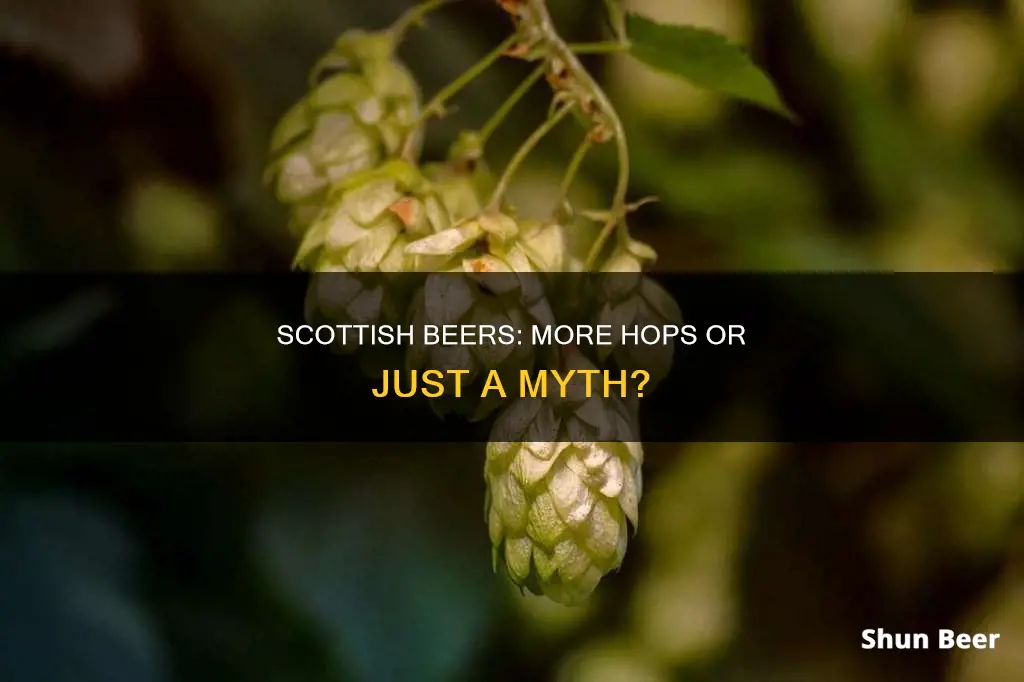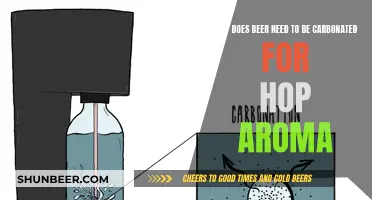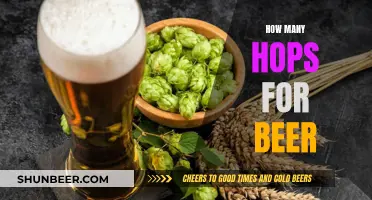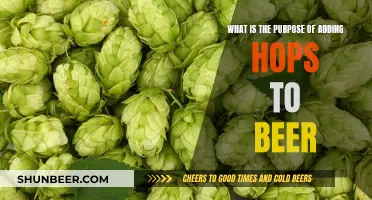
Scottish beers are known for their diverse ingredients and flavours, but do they have more hops? Brewing in Scotland dates back 5,000 years, with ancient techniques and ingredients remaining in use longer than in the rest of the UK. Beers were flavoured with indigenous plants and herbs such as heather, myrtle and broom, and while hops eventually replaced these herbs, Scottish beers are still known for their light hopping and subtle hop character. Scottish brewers resisted using hops for longer than most, and when they did, they used them sparingly due to the cost. So, while hops are an essential ingredient in beer, Scottish beers are characterised by their maltiness, with hops taking a back seat.
| Characteristics | Values |
|---|---|
| Hops in Scottish Beers | Used sparingly |
| Comparison with English Beers | Similar use of hops in a Scottish pale ale to an English one |
| History of Scottish Beers | Brewing in Scotland goes back 5,000 years |
| Ale was flavoured with meadowsweet, heather, myrtle and broom | |
| Hops replaced herbs in Scotland by the end of the 19th century | |
| Scottish beers were highly-regarded and exported around the world | |
| Scottish beers were exported to the British colonies, rivalling those of Burton brewers | |
| Scottish brewers used the same amount of hops as English brewers | |
| Scottish beers were darker and more focused on caramel and toffee notes |
What You'll Learn
- Scottish beers are malty in essence, with hops taking a back seat
- Hops were imported from England and were expensive
- Scottish beers were flavoured with herbs and flowers before hops
- Scottish brewers used aged hops, which lost bittering qualities
- Scottish brewers adapted to their distinctive climate, which is similar to Bavaria

Scottish beers are malty in essence, with hops taking a back seat
Scottish beers are typically malty in character, with hops taking a back seat. This is partly due to the fact that hops do not grow well in Scotland, and also because of the historical use of herbs and flowers to flavour beer. Beers from Scotland are often described as having a smooth, full, and malty character, with a dryish finish.
The use of bittering herbs such as heather, myrtle, and broom to flavour and preserve beer continued longer in remote parts of Scotland than in the rest of the UK. In 1769, Thomas Pennant wrote that on the Isle of Islay, "ale is frequently made of the young tops of heath, mixing two-thirds of that plant with one of malt, sometimes adding hops". Hops had replaced these herbs in Scotland by the end of the 19th century, but the tradition of using herbs was revived in the 1990s by a Scottish brewer, the Williams Brothers.
Scottish brewers resisted using hops for longer than other brewers, and when they did, they used them sparingly due to the cost. Hops had to be imported, so to avoid shipping costs, hops were stored and aged, which reduced their bittering qualities. Scottish beers are therefore often described as having little hop aroma and a low hop character.
Scottish ales are top-fermented and cold-conditioned in the manner of lager brewers of Bavaria and Bohemia. The result is a deep, rich colour and a smooth, unassuming depth of character. Scottish ales are also lightly hopped, with little hop aroma.
Scottish beers are a hybrid, with largely indigenous ingredients lending finesse to brews that otherwise owe their profile to the disparate brewing cultures of England and Germany. Scotland is famous for its barley, both northern whiskey and southern ale varieties. The southern variety is the same stock used in English and Irish ales and is rich and substantial, even in its most lightly kilned form.
Hops: Brewing Demand and Future Growth
You may want to see also

Hops were imported from England and were expensive
Hops have never been a focal point of beers brewed in Scotland, a land where hops do not grow. Instead, Scottish beers are known for their rich maltiness, with a hop character kept in the background.
Scottish ales are typically malt-forward, smooth, and warming, with a boozy finish. The story goes that Scotland's climate has always been too chilly for growing hops on a large scale. As hops had to be imported from England, they were expensive and hard to come by, so the Scots made do with what they had. This often meant using very few hops or none at all. Brewers would sometimes use heather flowers, broom, myrtle, or other herbs and flowers instead of hops. This tradition dates back some 4,000 years, with heather ales and meads being ceremonial drinks for the Celts, possibly aided by hallucinogenic moss that can grow on the flowers.
In the 19th century, hops were introduced to Scotland from warmer, sunnier England, but the use of flowers and herbs in beer continued. The Celtic tradition of using bittering herbs persisted longer in remote parts of Scotland than in the rest of the UK. Thomas Pennant wrote in "A Tour in Scotland" in 1769 that on the island of Islay, "ale is frequently made of the young tops of heath, mixing two-thirds of that plant with one of malt, sometimes adding hops."
While hops were used in Scottish beers, they were often used sparingly due to their expense and the difficulty of obtaining them. This led to the development of Scottish beers with unique characteristics, significantly different from beers brewed in England. Scottish brewers took advantage of the hard water in Edinburgh, which was particularly suitable for brewing pale ales, and Scottish beers became known for their rich maltiness and smooth, warming qualities, rather than a strong emphasis on hops.
Hops' Role in Brewing: Aromatic and Bitter Beer Balancing
You may want to see also

Scottish beers were flavoured with herbs and flowers before hops
Brewing in Scotland dates back 5,000 years, with evidence suggesting that ale was made from barley at Skara Brae and other Neolithic sites. This ale was likely flavoured with meadowsweet, in the manner of a kvass or gruit—a blend of bitter herbs and flowers—made by various North European tribes, including the Celts and the Picts.
The ancient Greek Pytheas remarked in 325 BC that the inhabitants of Caledonia were skilled in the art of brewing a potent beverage. Indeed, the use of bittering herbs such as heather, myrtle, and broom to flavour and preserve beer continued longer in remote parts of Scotland than in the rest of the UK.
In his 1769 book, *A Tour in Scotland*, Thomas Pennant wrote that on the island of Islay, "ale is frequently made of the young tops of heath, mixing two-thirds of that plant with one of malt, sometimes adding hops". However, by the end of the 19th century, hops had replaced herbs in Scottish brewing, mirroring a broader transition that had already occurred in the rest of Britain.
Before the adoption of hops, Scottish beers were flavoured with a variety of herbs and flowers, including dandelion, burdock root, marigold, horehound, ground ivy, and heather. This practice was not unique to Scotland, as gruit ales were common throughout medieval Europe. However, the transition to hops in Scotland occurred later and more gradually than in other parts of the UK, with some remote areas of Scotland continuing to use traditional herbs for flavouring well into the 18th century.
Dry Hopping Beer: Contamination Risk or Myth?
You may want to see also

Scottish brewers used aged hops, which lost bittering qualities
Scottish beers are often malty and low-hopped, with little hop aroma. This is partly because hops do not grow well in Scotland, so brewers there had to import them, incurring shipping costs. To save money, Scottish brewers would store hops, and also use aged hops, which lost some of their bittering qualities.
Hops were introduced to Scotland in the 19th century, but before this, beers were flavoured with herbs and flowers such as heather, myrtle, broom, and meadowsweet. In 325 BC, the ancient Greek Pytheas remarked that the inhabitants of Caledonia were skilled brewers of a potent beverage. In the 18th century, Thomas Pennant wrote that on the Isle of Islay, "ale is frequently made of the young tops of heath, mixing two-thirds of that plant with one of malt, sometimes adding hops".
The use of bittering herbs to flavour and preserve beer continued longer in remote parts of Scotland than in the rest of the UK. However, by the end of the 19th century, hops had replaced herbs in Scottish brewing, as they had in the rest of Britain.
In the 1800s, Scottish beers were markedly different from those brewed in the country today. Modern Scottish ales have a more subdued flavour profile, with a lower final gravity.
Where to Find Tropical Hop Beer Near You
You may want to see also

Scottish brewers adapted to their distinctive climate, which is similar to Bavaria
Scottish beers do not necessarily have more hops. In fact, hops were introduced to Scotland from warmer, sunnier England in the 19th century. Prior to this, Scottish beers were flavoured with bittering herbs such as heather, myrtle, and broom.
Scottish brewers adapted to their distinctive climate, which shares similarities with Bavaria. Scotland's climate is mostly temperate and oceanic, warmed by the Gulf Stream from the Atlantic. Similarly, Bavaria's climate is classified as "Cfb" or "Dfb" at lower elevations, and "Dfc" and "ET" at higher altitudes. Both regions experience a significant amount of rainfall, with eastern Scotland receiving less precipitation due to the rain shadow of the western uplands. The western highlands of Scotland are among the wettest places in Europe, while parts of eastern Scotland, such as Inverness and the coasts of Lothian, Fife, Angus, and eastern Aberdeenshire, are comparatively drier.
The temperate climate of Scotland and Bavaria presents challenges and opportunities for growing hops. In Scotland, the short growing season and wet conditions can impact the yield and quality of hops. Similarly, Bavaria's Hallertau region, known for its hop-growing, experiences high rainfall, which can affect the growth and flavour of hops. However, both regions have a history of successful hop cultivation, with Scottish brewers in Edinburgh using hops as much as English brewers, and Bavarian hops being exported worldwide.
In addition to climatic similarities, Scotland and Bavaria share a history of beer-making traditions. Brewing in Scotland dates back 5,000 years, with ancient brewing techniques and ingredients remaining in use longer than in the rest of the UK. Similarly, Bavaria has a long tradition of brewery, with nearly half of all German breweries located in the region. Both cultures have strict regulations surrounding beer production, with Scotland's Leges Quatuor Burgorum, a code of burgh laws, and Bavaria's Reinheitsgebot, or beer purity law, which allowed only water, barley, and hops as ingredients.
Sour Beers: Do They Have Hops?
You may want to see also
Frequently asked questions
Scottish beers do not have more hops. In fact, Scottish beers are known for being lightly hopped.
Hops do not grow well in Scotland. As a result, hops were historically expensive in Scotland, and brewers used them sparingly.
Scottish beers were flavoured with herbs and flowers until the introduction of hops in the 19th century.
Before hops, Scottish beers were flavoured with indigenous plants and herbs, including heather, myrtle, broom, and meadowsweet.
Some Scottish brewers have revived the use of herbs and flowers in their beers, but most Scottish beers today are lightly hopped.







